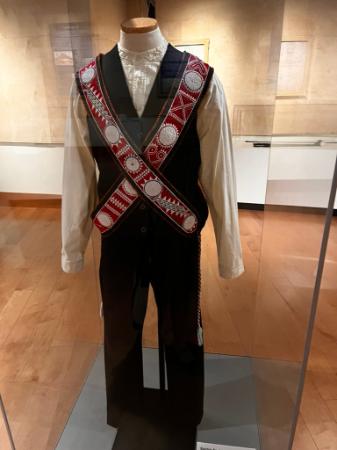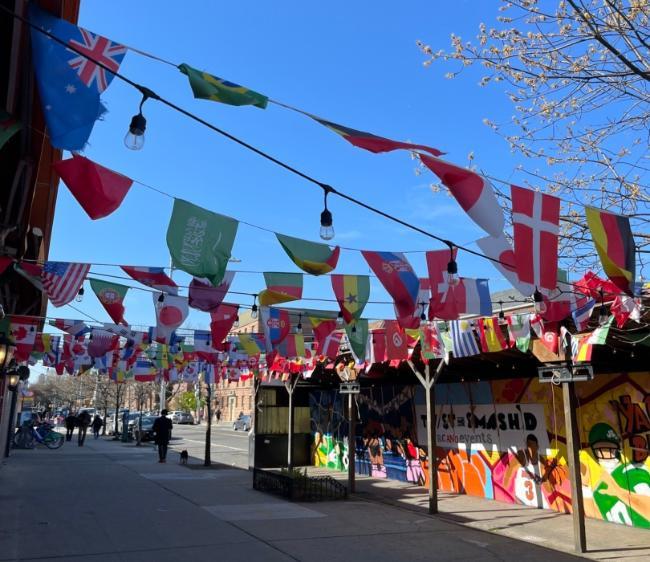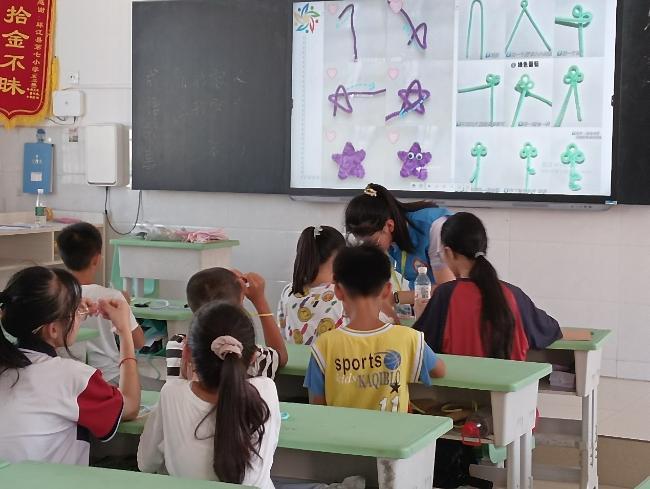A Look into Anthropological Fieldwork at TC
Students in Programs in Anthropology engage in ethnographic fieldwork with communities around the world, from street vendors in New York City to elementary school classes in Beijing. We are excited to share a look into some of the experiences our students have had in the field.

Alicia Banks, Ph.D. Candidate in Anthropology & Education
Solar do Unhão, Salvador, Bahia
"Open-air soccer court decorated with a wall mural completed by a local artist from the nearby Museum of Modern Art of Bahia. The mural features aspects of Afro-Brazilian culture blended with images of Afro-Bahian daily life. It depicts elements of the syncretic religion Candomblé, evidenced by the figures in blue and white, wearing beaded necklaces and holding baskets of flower bouquets, as well as the female figure of the mermaid. Also featured are commercial activities such as fishing and boating which many residents in the community rely on for survival. There are also references to the Afro-Brazilian music group Filhos de Gandhy (Sons of Ghandy), demonstrated by the male figure in white (lower left). The community where the soccer court is located is only accessible by foot and has limited access to basic sanitation and other public resources. It is considered a “bairro popular” (popular neighborhood), a term often used to describe impoverished communities in Salvador, Bahia. However, the neighborhood within which the community is situated- Solar do Unhão- also includes a newly renovated architectural complex in which the Museum of Modern Art is situated, a state-of-the-art, Bahian state-funded facility."

Anna Burns, Ph.D. Student in Anthropology & Education
Cusco, Peru
"Here is the view from the front gate of my second field site during [my] trip in the Fall of 2018. This school, the Instituto de Educacion Superior Pedagoico Pukllasunchis, was a private school located in the San Blas district of Cusco. They also taught the bilingual and intercultural education model. These students, however, were very different from those I experienced in the peri-urban school."


Anna Burns, Ph.D. Candidate in Anthropology & Education
Choctaw Nation of Oklahoma Reservation, Durant, Oklahoma
"These were all taken in Durant, Oklahoma, on the Choctaw Nation of Oklahoma reservation between May and August, 2024. The photo of the building is the Choctaw Nation's headquarters building, where all official governmental officials like the Chief work, and tribal membership is processed. The outfit was part of a special exhibit demonstrating the trade relationship that the Choctaw Nation had with the French in the early 1800s. The Baldric sashes (beaded pieces) are a modern recreation of the kinds of pieces that Choctaw people would have worn at that time. These pieces were used to denote status and identity from a distance and were typically red fabric."

Laura Coleman, MA in Anthropology & Education 2024 Alum
Astoria, Queens, New York
"Photograph of a variety of countries’ flags on the sidewalk near the corner of Steinway Street and 34th Avenue in Astoria, Queens, New York. Located across the street from Mahmoud’s Corner, a food truck founded and operated by Egyptian immigrants to New York City since the late 1980’s. We interviewed employees of Mahmoud’s Corner as a part of ethnographic research on the overlapping themes of globalization, mobility, and education as they appear in the experiences of street vendors working in halal food trucks in New York City. Research conducted by Halah Alsenan, Mara Espinoza, and Laura Coleman, Anthropology & Education students at Teachers College."

Muyan Guo, MA Student in Anthropology & Education
Maonan County, Guangxi, China
"We are from the Academic Center of the Beijing-Guangxi College Students Association in China, established on Oct. 26th, 2021. Our primary focus is on promoting rural-urban educational equality in China. Every summer, we engage college students as volunteer teachers to host camps in about 20 underserved rural areas in Guangxi Province. During these camps, we conduct brief fieldwork, observing rural students aged 6-13 and interviewing their parents and local educators. In the accompanying photo, one of our volunteers teaches art to Grade 3 students at No. 7 Maonan County Primary School. They're learning to knit a star, an activity that helps our teachers quickly bond with the students, paving the way for family interviews."


Skylar Kaat, Ph.D. Candidate in Anthropology & Education
"fieldwork sketches," China
"During the first weeks of my fieldwork, I diligently took notes with a small notebook and pen. It didn’t take long before my Chinese-speaking interlocutors noticed my wildly cursive English handwriting. Intrigued by this unfamiliar script, many of them teased/asked, “What is this?” “Are you doodling?” “Draw me something!”
As our familiarity grew, I started bringing charcoal, and soon colored pencils, watercolors, and even oil pastels. Upon my daily arrival, I'd ceremoniously lay out my supplies, and my interlocutors, in turn, would flip through and comment as they watched me draw - it became a ritual that fostered a unique bond.
These artworks were not only a means of documenting, as mnemonic devices for my subsequent writings. More profoundly, the creations became a form of seeing, as an anthropologist and as a person, I bore witness to the emotions, complexities, and joy of the moments there and then."
Learn more about skylar’s fieldwork sketches project: Instagram @field.art.works


Haley Planicka, MA Student in Anthropology & Education
"Second year Master's student Haley Planicka spent her summer in the Southern Arizona borderlands working with humanitarian organizations to help people seeking asylum as part of her research concerning disappearances, agency, and power along the US-Mexico border."
Thank you to all of the students who contributed their photographs, artwork, and field experiences!
